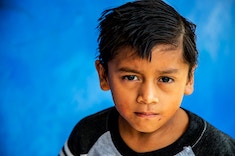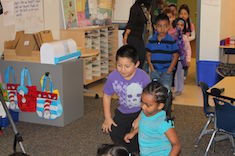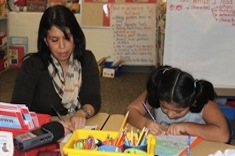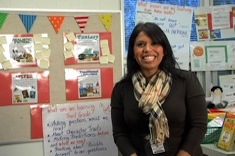I would often ask myself: What’s the kind thing to do? What is the right thing to do?
—Jacqueline Woodson
How can anyone forget the face of a child that looks excited, curious, and terrified at the same time? How can anyone forget the face of a child that conveys, “I’m new here. I don’t understand what you are saying, but I’m here!”
When a new student who has just arrived in the country steps into our classrooms, I’m reminded that being courageous is hard work. And as much as we are nervous about working with English learners who don’t speak any English yet, nothing compares with what that child feels walking into an unknown world. After all, it’s not only the language that is new for this student but also all the cultural layers he or she will be discovering in the upcoming weeks and years.
On a rainy Wednesday morning, I’m reminded of this hard work that our courageous newcomers face. “Welcome to our school, Kadir!” I hear the principal say when Kadir and his family walk through our school doors for the first time. Kadir has a big smile. He is excited to be here, I think. I shake his hand. He has a firm handshake, and makes eye contact. I’m already in awe of the way Kadir is trying to communicate with me through his eyes and smile. We walk Kadir to his classroom, where a new beginning awaits. Kadir replicates the kindness he showed me with his teacher: a smile, eye contact, and a firm handshake.
I leave Kadir so his journey can begin. There’s a lot I’ll be looking forward to learning about Kadir in the next couple of weeks, but for now I know these things for sure from reading his previous school records and from this morning interaction with him and his family:
-
Kadir is brave. Kadir is kind.
-
He has received formal schooling and completed kindergarten through second grade.
-
There are no interruptions in his education that we should be concerned about.
-
He understands that school is a learning place.
-
He is literate in his first language: He can read, write, and do math calculations in Arabic.
-
The family keeps saying, “Thank you, thank you, thank you.” They are so grateful to be here.
Four hours later, I’m excited to hear from his teacher about Kadir’s first day of school. I’m eager to hear the stories of courage and hope, but also to start talking about instructional moves. However, when I step into the classroom, I find a frustrated teacher. “Oh no! What happened?” I ask. I am afraid to hear that he had a rough morning with tears of frustration. So I ask, “Is Kadir okay?”
“He’s FINE!” replies his teacher testily. I’m confused. What is the problem then? “Stella, I want to know. Is there something like a packet that I can give Kadir? You know, something that he can complete on his own, at least for the first couple of days?” The word packet keeps being repeated in my head.
“Every child is different,” I say. “We don’t know what the child knows or doesn’t know until they are here with us. I know it’s hard, but we’ll be in this discovery zone as we get to know Kadir more. But we’ll be doing this work together,” I reassure her.
What happens next is a scene I replay often in my head. “Ugh! I tried,” the teacher says as she pulls several math sheets out of the recycling bins, pages with tracing and counting numbers from 1 to 20. “This was too easy for Kadir!” she announces.
Yes. Of course it was too easy. Kadir may not speak the language, but he has had uninterrupted schooling experience. That means his academic instruction and groundwork is solid. The assumption is that Kadir doesn’t know anything. The assumption is that since Kadir doesn’t speak English, he is behind in all academic areas. Where do these assumptions and deficit beliefs come from? Clearly the teacher is frustrated. She is overwhelmed, and a package of activities and worksheets is all she can think of as a solution for Kadir.
As a coach, my mind races with questions and thoughts. The students’ needs are always at the heart of our decisions. But in this case, the teacher wants me to put her needs first by giving Kadir “busywork” to complete.
After my initial shock, I know I have to give this teacher practical tools and ideas so she can navigate this unknown world with ease. What do I know about her classroom?
-
This is a classroom of third graders. They are independent learners and always eager to help.
-
Morning meeting is a consistent practice in her classroom.
-
They have different technological tools available, including iPads.
-
Kadir might not have a language partner (another student who speaks his first language), but he has 24 classmates in this community.
“I know this feels very heavy right now—just like it might feel for Kadir because he doesn’t speak English yet. But you don’t have to put this all on your shoulders. You’ve got a community of 24 learners who can help you with this transition,” I explain. “Kadir’s arrival is a great opportunity to rethink some of the things we do and how we can share the responsibilities with others. Children are natural helpers. You can ask your students about becoming class ambassadors who will support not only Kadir but also the future children like him who step into your classroom. Together they can create ideas about how to give Kadir a tour of the school and explain how different areas in our school work. They can create videos and photo cards to help Kadir navigate the day and daily schedule. While the kids help us with this, we’ll get to know Kadir more and get a stronger academic plan in place.”
The next words tell me all I need to know. “Stella, I don’t have time for this. We hit the ground running every day. There’s a lot I have to teach.” And just like that, our conversation is over. She said what was on her mind. I offered the possible solutions I had at the moment. This is one of those coaching stories that doesn’t have a happy ending.
But this story is not about me. It’s not about her. This story is about Kadir and his right to learn, his right to an educational environment that supports him wherever he is in his academic and language journey. His right to have a caring environment. His right to count on the support and guidance of his teachers.
I didn’t get my message across with this teacher. Things didn’t get better with her. Our professional relationship was not the same after that conversation. And that’s okay with me. But what will never be okay is to disregard our English learners because “There’s too much to teach” and “Who has time for that?” are our stock responses. It will never be okay to make a child invisible and ignore his needs. So I needed to stand up for Kadir, but also for all the English learners in our school. I reached out to other support staff members whom I knew I could count on for support. Kadir was not left behind. Kadir was not invisible. We made sure he had books. He had conversations. He had friendships and support.
The class ambassadors idea is in fact now a project in the making. After I approached the principal and shared the conversation that had led to this situation, he helped shaped the project. It takes a village to support our striving learners. It takes a village to notice and act accordingly. Children are natural helpers. They are inclined to help everyone if we reach out to them.
Now the school counts on class ambassadors to walk our new students around the school. They teach other children our lunch systems and explain how playground equipment is used. They share the do’s and don’ts of being a learner in an American classroom. I can count on these children to show up ready to help, as well as on their smiles, a universal love language. I can count on their friendships to these newcomers. Children supporting children: How incredibly courageous and inspiring is that?








